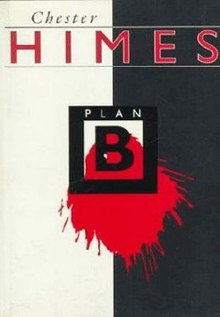 By CHESTER HIMES (University Press of Mississippi; 1993)
By CHESTER HIMES (University Press of Mississippi; 1993)
A posthumously published novel by the late Chester Himes (1909-1984) that like most posthumously published novels has a number of problems. PLAN B was ostensibly an entry in Himes’s Harlem Detective series of quirky hard boiled novels featuring the characters Coffin Ed Johnson and Grave Digger Jones, yet Johnson and Jones only appear in the beginning and end of this novel (to get killed). That ending, BTW, was reconstructed by the editors from notes Himes left behind, as the novel was left uncompleted in his lifetime (for the record, it was first published in French in 1983 and debuted in English a decade later).
PLAN B is, quite simply, a mess. Drafted in the early 1970s (alongside several other similarly themed novels), it’s an angry and satiric fantasy about an attempted overthrow of white America. Tomsson Black, the instigator of this rebellion, is a wealthy black man who ships out high powered rifles to random black folk with instructions to wait for an official command to use them. But of course the plan goes awry almost immediately, with the first recipient, an unemployed Harlem resident, getting into a scuffle with his more radically-minded prostitute wife and slashing her to death in the process (which, as Himes fans may recognize, is actually the text of his 1967 short story “Tang,” which provided the impetus for this novel). This is followed by a rash of random black-on-white shootings, which inflames the white ruling class and leads to much harassment of the African American populace, and culminates in the eventual re-instatement of slavery(!).
The official reason for the abandonment of PLAN B, as outlined in a lengthy introduction by the book’s editors Michel Fabre and Robert E. Skinner, is that Himes “may have reached an ideological impasse” given his distaste for violence. Violent is definitely the term for this novel, which positively revels in brutality and bloodletting. The other major driving point is desire, which provides the impetus for the uprising—courtesy of a lustful white woman who seduces and then has the aforementioned Tomsson Black arrested for rape—and recurs in passages like this one: “during this terrible period, whites experienced a variety of assorted nightmares, all of which featured the enlarged sexual organs of black males.”
Such a wild mixture of tone and subject matter is every bit as discordant as it sounds, and set down in alternately rushed and overwrought prose that all-but broadcasts its first draft status (I’m not sure I buy Fabre and Skinner’s claim that Himes’s intent was “surreal”). There are some good things, though.
Himes’ satiric skill is fully evident in his skewering of both white and black fallacies, sometimes in a single sentence (“There were a few extremists who bent over and offered their asses for blacks to kick, but blacks weren’t sure whether they were meant to kick them or kiss them, so in their traditional manner, they cautiously avoided making any decision at all”), while certain passages, such as an early one about Harlem in the summertime (“this heat, which is stored in the squalid slum environs and dirty black bodies of the residents of Eighth Avenue, merely serves to sizzle them in the summer when they least need it and vanishes in the winter”), are quite brilliant in their insight and descriptive power. So PLAN B may not entirely work, but it’s not a failure by any means.
